Heat Wave
Late Neolithic Monument
By DANIEL WEISS
Monday, October 15, 2018
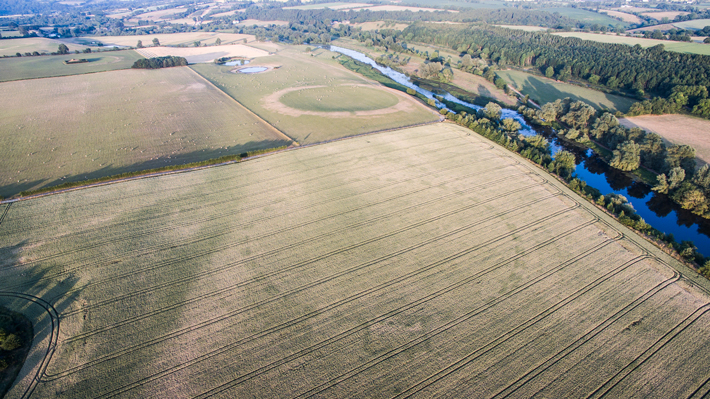 Brú na Bóinne, or the Palace of the Boyne, on Ireland’s east coast, features an astounding concentration of prehistoric monuments. More than 90 are known in all, and summer 2018’s scorching weather has added yet another—only traces of which were seen in a previous lidar survey. Located just north of the River Boyne, the new monument dates to 2900–2500 B.C. and became visible in pits, postholes, and sections of ditch.
Brú na Bóinne, or the Palace of the Boyne, on Ireland’s east coast, features an astounding concentration of prehistoric monuments. More than 90 are known in all, and summer 2018’s scorching weather has added yet another—only traces of which were seen in a previous lidar survey. Located just north of the River Boyne, the new monument dates to 2900–2500 B.C. and became visible in pits, postholes, and sections of ditch.
The monument, which likely served as a site for rituals, features a circular double ditch broken up into sections. The entire complex is surrounded by a double ring of timber posts. “The posts may have been connected in some way to create a wall or fence,” says archaeologist Stephen Davis of University College Dublin. Sectioned ditches are nearly unknown in the late Neolithic, according to Davis, and while double rings of posts dating to the period have been found in Scotland, they had never before been found in Ireland. A box-shaped structure on the monument’s western side once had particularly large posts, and may have served as an entrance. Davis notes that the newly discovered monument probably had some relationship to another one just to its southeast, which also appeared this summer as a wide, desiccated ring marking what was once an earthen or stone bank.
WWI Military Camp
By JARRETT A. LOBELL
Monday, October 15, 2018
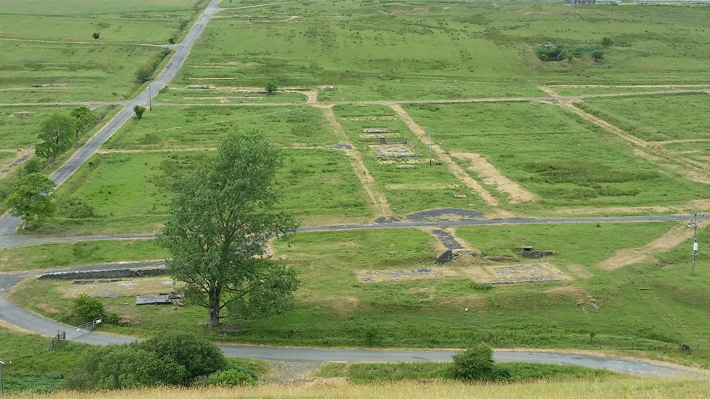 In the very early years of the twentieth century, the Stobs Military Camp served as a training ground and living quarters. Just before World War I, it was the place where Scotland readied for combat. And during the war, it became a POW camp where both civilian and military prisoners were housed in 80 wooden huts that each measured 120 by 20 feet and were surrounded by barbed wire. Stobs eventually closed in 1957, and its layout is reasonably well known from the master plan drawn up in 1917. According to Andrew Jepson of Archaeology Scotland, however, parts of the camp that hadn’t been seen in many years became evident during summer 2018’s heat wave. “We clearly knew that the building foundations and networks of paths were there, but over the decades they had become difficult to identify in some areas as nature began to reclaim the land,” says Jepson. “An attempt to locate precisely some of the corners of the barracks hut foundations last year proved relatively unsuccessful,” he adds, “so we were excited to see so much of the camp appear before our eyes.”
In the very early years of the twentieth century, the Stobs Military Camp served as a training ground and living quarters. Just before World War I, it was the place where Scotland readied for combat. And during the war, it became a POW camp where both civilian and military prisoners were housed in 80 wooden huts that each measured 120 by 20 feet and were surrounded by barbed wire. Stobs eventually closed in 1957, and its layout is reasonably well known from the master plan drawn up in 1917. According to Andrew Jepson of Archaeology Scotland, however, parts of the camp that hadn’t been seen in many years became evident during summer 2018’s heat wave. “We clearly knew that the building foundations and networks of paths were there, but over the decades they had become difficult to identify in some areas as nature began to reclaim the land,” says Jepson. “An attempt to locate precisely some of the corners of the barracks hut foundations last year proved relatively unsuccessful,” he adds, “so we were excited to see so much of the camp appear before our eyes.”
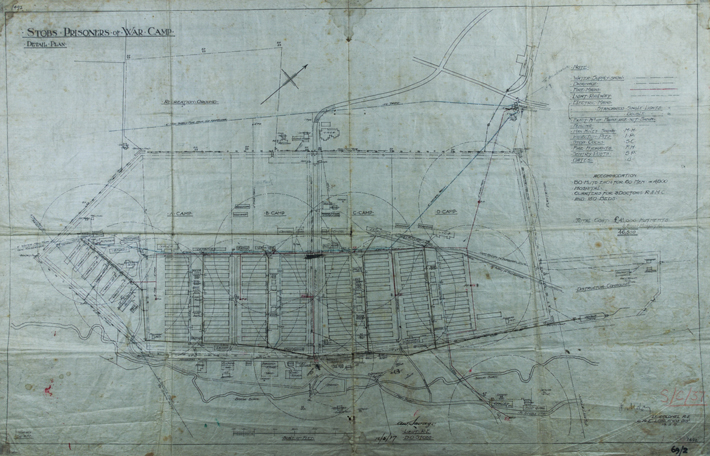
WWII Air Raid Shelter
By JARRETT A. LOBELL
Monday, October 15, 2018
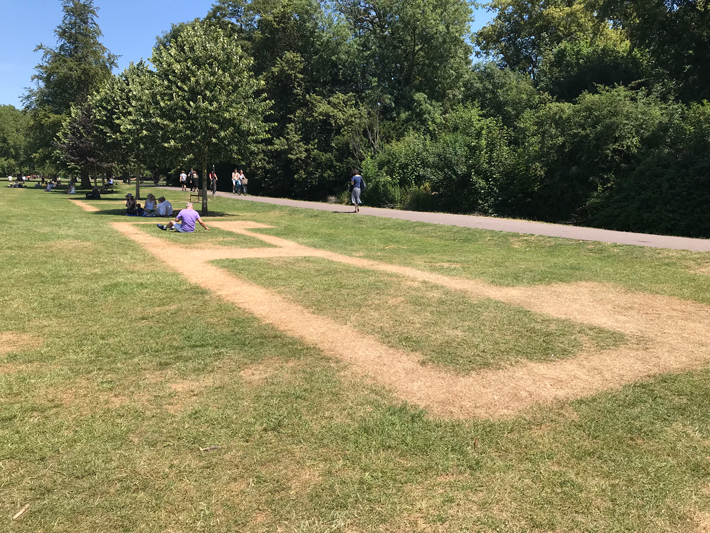 During the Second World War, Cambridge, like most of England, was under threat of aerial bombardment. The first daylight raids over the country took place in June 1940, and they continued throughout the remainder of the war, killing some 40,000 civilians. Though Cambridge itself was not badly hit, the city experienced 424 air raid alerts during which high-explosive bombs, oil bombs, and other incendiaries were dropped, killing 29 people. Some of the city’s residents may have hidden in a concrete air raid shelter built under the green of Jesus College in 1939. Its outlines are an unexpected reminder of the war only recently made visible.
During the Second World War, Cambridge, like most of England, was under threat of aerial bombardment. The first daylight raids over the country took place in June 1940, and they continued throughout the remainder of the war, killing some 40,000 civilians. Though Cambridge itself was not badly hit, the city experienced 424 air raid alerts during which high-explosive bombs, oil bombs, and other incendiaries were dropped, killing 29 people. Some of the city’s residents may have hidden in a concrete air raid shelter built under the green of Jesus College in 1939. Its outlines are an unexpected reminder of the war only recently made visible.
Medieval Castle
By ERIC A. POWELL
Monday, October 15, 2018
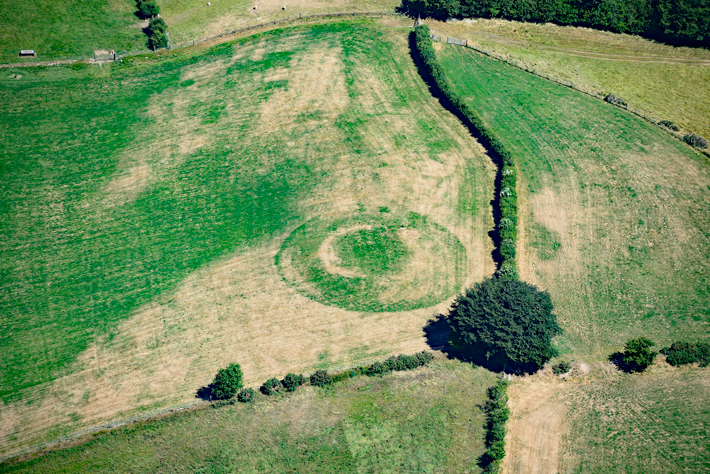 The raised earthwork motte, or mound, of Castell Llwyn Gwinau, a medieval fortification that sits atop an isolated hill in western Wales, is about five feet high and some 100 feet in diameter. This remote spot is not obviously strategic, and it is possible the tenant of a nearby farmstead built the castle simply to signal his position as a knight. Although the location of the castle was known, the drought made its layout clear. Brown sections at its summit likely mark the remains of a stone wall, and a green ring indicates its ditch. The Royal Commission on the Ancient and Historical Monuments of Wales discovered at least 100 sites during the heat wave. “So much new archaeology is showing, it is incredible,” says Toby Driver, the commission’s senior aerial investigator. “The summer’s urgent work in the air will now lead to months of research in the office in the winter months to map and record all the sites which have been seen and to reveal their true significance.”
The raised earthwork motte, or mound, of Castell Llwyn Gwinau, a medieval fortification that sits atop an isolated hill in western Wales, is about five feet high and some 100 feet in diameter. This remote spot is not obviously strategic, and it is possible the tenant of a nearby farmstead built the castle simply to signal his position as a knight. Although the location of the castle was known, the drought made its layout clear. Brown sections at its summit likely mark the remains of a stone wall, and a green ring indicates its ditch. The Royal Commission on the Ancient and Historical Monuments of Wales discovered at least 100 sites during the heat wave. “So much new archaeology is showing, it is incredible,” says Toby Driver, the commission’s senior aerial investigator. “The summer’s urgent work in the air will now lead to months of research in the office in the winter months to map and record all the sites which have been seen and to reveal their true significance.”
Roman Fort
By DANIEL WEISS
Monday, October 15, 2018
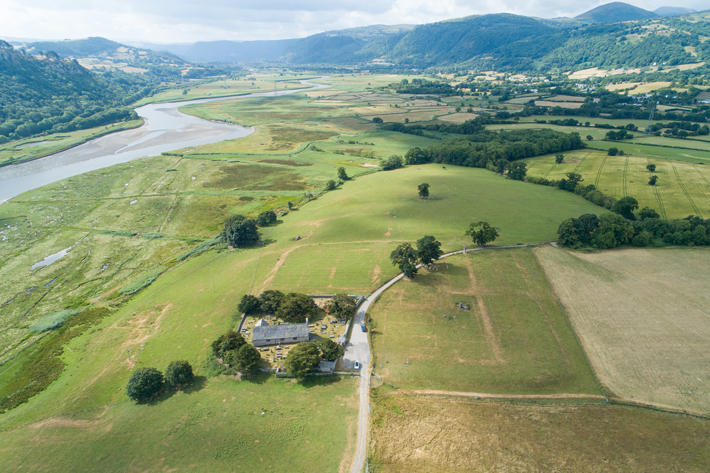 Canovium was one of a network of wooden forts that housed tens of thousands of troops during the Roman invasion of Wales in the first century A.D. Around A.D. 120, when many of these soldiers were shipped north to work on Hadrian’s Wall, Canovium was among the forts in Wales made permanent and rebuilt in stone. This past summer, evidence of these stone walls appeared, with just the northeast corner obscured by a still-active medieval parish church.
Canovium was one of a network of wooden forts that housed tens of thousands of troops during the Roman invasion of Wales in the first century A.D. Around A.D. 120, when many of these soldiers were shipped north to work on Hadrian’s Wall, Canovium was among the forts in Wales made permanent and rebuilt in stone. This past summer, evidence of these stone walls appeared, with just the northeast corner obscured by a still-active medieval parish church.
Based on previous excavations and historical sources, says archaeologist Peter Guest of Cardiff University, the fort is known to have been home to an auxiliary unit. Its 500 soldiers were drawn, at least initially, from recently conquered peoples—most likely Batavians, Gauls, or Thracians. “The fort was occupied for 200 years or more,” says Guest. “It wouldn’t be surprising then if a number of the recruits that lived there grew up just outside the fortress. They were the sons of existing soldiers and the grandsons of soldiers before them.”
Advertisement
Advertisement
IN THIS ISSUE
Advertisement

Recent Issues
-
 May/June 2024
May/June 2024
-
 March/April 2024
March/April 2024
-
 January/February 2024
January/February 2024
-
 November/December 2023
November/December 2023
-
 September/October 2023
September/October 2023
-
 July/August 2023
July/August 2023
-
 May/June 2023
May/June 2023
-
 March/April 2023
March/April 2023
-
 January/February 2023
January/February 2023
-
 November/December 2022
November/December 2022
-
 September/October 2022
September/October 2022
-
 July/August 2022
July/August 2022
-
 May/June 2022
May/June 2022
-
 March/April 2022
March/April 2022
-
 January/February 2022
January/February 2022
-
 November/December 2021
November/December 2021
-
 September/October 2021
September/October 2021
-
 July/August 2021
July/August 2021
-
 May/June 2021
May/June 2021
-
 March/April 2021
March/April 2021
-
 January/February 2021
January/February 2021
-
 November/December 2020
November/December 2020
-
 September/October 2020
September/October 2020
-
 July/August 2020
July/August 2020
-
 May/June 2020
May/June 2020
-
 March/April 2020
March/April 2020
-
 January/February 2020
January/February 2020
-
 November/December 2019
November/December 2019
-
 September/October 2019
September/October 2019
-
 July/August 2019
July/August 2019
-
 May/June 2019
May/June 2019
-
 March/April 2019
March/April 2019
-
 January/February 2019
January/February 2019
-
 November/December 2018
November/December 2018
-
 September/October 2018
September/October 2018
-
 July/August 2018
July/August 2018
-
 May/June 2018
May/June 2018
-
 March/April 2018
March/April 2018
-
 January/February 2018
January/February 2018
-
 November/December 2017
November/December 2017
-
 September/October 2017
September/October 2017
-
 July/August 2017
July/August 2017
-
 May/June 2017
May/June 2017
-
 March/April 2017
March/April 2017
-
 January/February 2017
January/February 2017
-
 November/December 2016
November/December 2016
-
 September/October 2016
September/October 2016
-
 July/August 2016
July/August 2016
-
 May/June 2016
May/June 2016
-
 March/April 2016
March/April 2016
-
 January/February 2016
January/February 2016
-
 November/December 2015
November/December 2015
-
 September/October 2015
September/October 2015
-
 July/August 2015
July/August 2015
-
 May/June 2015
May/June 2015
-
 March/April 2015
March/April 2015
-
 January/February 2015
January/February 2015
-
 November/December 2014
November/December 2014
-
 September/October 2014
September/October 2014
-
 July/August 2014
July/August 2014
-
 May/June 2014
May/June 2014
-
 March/April 2014
March/April 2014
-
 January/February 2014
January/February 2014
-
 November/December 2013
November/December 2013
-
 September/October 2013
September/October 2013
-
 July/August 2013
July/August 2013
-
 May/June 2013
May/June 2013
-
 March/April 2013
March/April 2013
-
 January/February 2013
January/February 2013
-
 November/December 2012
November/December 2012
-
 September/October 2012
September/October 2012
-
 July/August 2012
July/August 2012
-
 May/June 2012
May/June 2012
-
 March/April 2012
March/April 2012
-
 January/February 2012
January/February 2012
-
 November/December 2011
November/December 2011
-
 September/October 2011
September/October 2011
-
 July/August 2011
July/August 2011
-
 May/June 2011
May/June 2011
-
 March/April 2011
March/April 2011
-
 January/February 2011
January/February 2011
Advertisement






